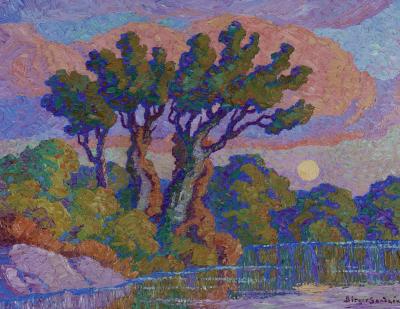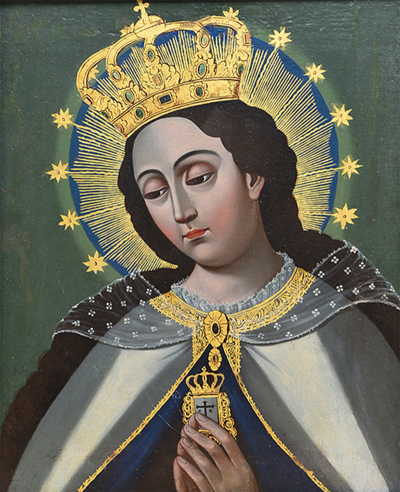El Greco to Velazquez
This archive article was originally published in the Spring 2008 issue of Antiques & Fine Art magazine.
El Greco and Velázquez are the twin giants of sixteenth- and seventeenth-century Spanish painting. They loom so large that it can be hard to see past them and discern the wider artistic landscape in Spain at the moment when it was the richest and most powerful kingdom in Europe. Part of the difficulty lies in the fact that there is no single story line to Spanish art during the early decades of the seventeenth century—the period that encompasses both El Greco’s profoundly mystical late works and Velázquez’s strikingly clear-eyed early ones. There is no simple way to tell a story that goes directly from one artist to the other and explains both.
The root of the problem lies in the history of the Spanish kingdom itself. By 1600 Spain had a strongly centralized government, based in Madrid. But that was a relatively recent development, and regional centers such as Toledo and Seville retained vigorous cultural traditions of their own. Madrid served as the country’s artistic center, but influence still flowed as much from the provinces to the capital as in the other direction. It makes for a complex story, one that has rarely been told, and never as grandly as in the exhibition El Greco to Velázquez: Art during the Reign of Philip III.
El Greco to Velázquez brings together world-famous masterpieces and major works by artists who are not even household names in Spain itself. The exhibition also introduces the patrons who commissioned and owned the art. The tastes and collecting habits of King Philip III and his de facto prime minister, the Duke of Lerma, were extraordinarily influential, as courtiers aped them and assembled collections of their own. Despite the great stylistic diversity the show reveals, there are unifying themes as well, including the powerful influence of the Catholic devotional practices espoused by saints Ignatius of Loyola and Teresa of Avila. And a few old romantic myths fall along the way — most notably that of El Greco as an isolated genius, toiling in provincial obscurity. The exhibition puts El Greco’s late style into the context of the art made by his contemporaries and followers, where it in turn illuminates and complements their own moving works.
Nineteen-year-old King Philip III stands in sumptuous parade armor, the then-famous battle of Ostend (in present-day Belgium) raging behind him. The battle had been a major victory for Spain in a decades-long revolt by Dutch rebels against Spanish rule. He holds the baton that signifies command and points at the battle, a reminder of the power inherent in the Spanish crown. But Philip was never at Ostend. The battle, like the stiff posture, the extraordinarily expensive armor (most certainly not to be risked in battle), and the impractical neck ruff — all surrounding a basically anonymous face — are part of a carefully crafted picture designed to convey Philip’s power and right to rule rather than his personality or actual accomplishments. This is an official portrait, a picture of the monarchy, not a psychological study of the monarch.
Rubens was not a Spanish painter, but here he depicts the Duke of Lerma, one of the central figures in Philip III’s Spain and a key player in the exhibition. Lerma was Philip’s closest confidant and served, effectively, as prime minister. He was a notable patron of the arts, and the shape of El Greco to Velázquez is based partly on curator Sarah Schroth’s discovery and analysis of the inventories of his art collections. The portrait of Lerma is a reminder of how cosmopolitan Spain’s art world was in this period. Spain ruled parts of Italy and was one of the most potent forces in Italian politics. In fact, Rubens came to Spain as the diplomatic envoy of the Duke of Mantua, one member of a vast band of artists who traveled back and forth across the Mediterranean in these decades.
Domenikos Theotokopoulos, called simply El Greco—“The Greek”—in Spain, was born in Crete, but adopted Toledo as his home in the 1570s. He included the city in the background of several religious and mythological paintings, but this is the most important landscape by him to survive. In painting it, he may have drawn inspiration from a vogue for maps and city views, but El Greco’s Toledo is an imaginative reconstruction, not a careful, scientific rendering—a portrait of the city’s spirit more than its face. He has taken a position to the north, cropping and combining for visual effect; the cathedral, for example, which towers over the city here, would almost certainly have been invisible from this location. The result is an evocation of place rather than a simple depiction.
With its riot of colors and textures, this gigantic picture (it is more than ten feet high) is testament to the splendor cultivated during Philip’s reign. The holy family seems almost to be overwhelmed by the sumptuous clothes and spectacular headgear of the magi and their attendants. The artist’s career exemplifies the cosmopolitan world of Spanish painting in the decades after 1600. Maino’s parents were Italian and Portuguese, and the young artist probably trained in Italy. He has been linked with the great Italian painters Annibale Carracci and Guido Reni, but returned to Spain to work. At various times he lived in Toledo, Lisbon, and, eventually, Madrid, where he moved, in part, to take up the role of art tutor to Philip III’s son, the boy who would become King Philip IV.
Painters of the early seventeenth century captured brilliantly the profoundly felt, almost sensual version of Catholicism that had come to dominate Spanish religious life over the previous half century. Carducho depicts the moment when Saint Francis of Assisi, swept up in mystical rapture, was marked with the stigmata, the wounds Christ received during the crucifixion. The subject featured often in European art beginning in the fourteenth century, but Carducho’s version, where Francis rises up to meet the crucified Christ, as if to embrace him, was new. It could almost be a rendering, from the standpoint of an outside observer, of the sort of mystical transport described by Saint Teresa of Avila: “You see and feel it as a cloud, or a strong eagle rising upwards and carrying you away on its wings. I repeat it: you feel and see yourself carried away, you know not whither.”
The close mingling of the precise and realistic with the extravagant and theatrical is a particular characteristic of Spanish art in this period. Here, Ribalta shows with great care the chamber of Francis of Assisi, the thirteenth-century Italian saint who took a vow of absolute poverty and humility. The room’s contents bespeak a life of extreme simplicity: a rosary, a basket for alms, and a print, the cheapest form of art in the early seventeenth century. Ill, on a bed made only of a wooden platform, thin mattress, and rough woolen blanket, Francis experiences a vision. A muscular angel, playing a lute, has descended from heaven. But this is Francis’s vision alone. Despite the supernatural light that surrounds the angel, the saint’s companion, brother Leo, still needs a candle to read.
Still life was a new subject for artists around 1600. Painters had long included arrangements of objects — fruits, flowers, dead animals — in their works, but nearly always as bit players in paintings otherwise dedicated to religious or mythological stories. In the very late sixteenth century, artists throughout Europe suddenly began experimenting with “independent” still life, where those objects become the sole subject of the picture. Spanish painters were on the cutting edge of this exploration. Among the first, and arguably the greatest, of Spanish still-life painters was Juan Sánchez Cotán, who, for just a few years, dedicated himself to painting vegetables, fruit, and game. The artist revisited the same motifs and compositions over and over again, almost like a musical theme and variations. This is among his most austere and refined works: a simple, elegant curve traced by a quince, a cabbage, a melon, and a cucumber.
Painted when Velázquez was not yet twenty, this is a virtuosic exercise in observation and depiction. It is one thing to notice how an egg behaves when dropped into hot oil; it is entirely another to translate that transformation into paint. The picture is a near catalogue of the young artist’s ability to render different sorts of surfaces and materials: metal, both shiny and slightly dull; ceramic, glazed and unglazed, wet and dry; glass, wicker, wood, cloth; and skin, young and old. Yet the picture has no obvious story to tell. An old woman cooks eggs; a young boy arrives with a decanter and a melon. It is what seventeenth-century viewers would have called a bodegón — a glimpse into the low life, where events both colorful and unpredictable occurred.
El Greco to Velázquez is on view at the Museum of Fine Arts, Boston, through July 27. It then travels to Duke University’s Nasher Museum of Art, where it is on view from August 21 to November 9, 2008. The exhibition is curated by Ronni Baer, the Mrs. Russell W. Baker Senior Curator of European Paintings at the Museum of Fine Arts, and Sarah Schroth, the Nancy Hanks Senior Curator at the Nasher.
-----
Benjamin Weiss is manager of adult learning resources at the Museum of Fine Arts, Boston.
Images courtesy of the Museum of Fine Arts, Boston.
This article was originally published in the Spring 2008 issue of Antiques & Fine Art magazine. AFA is affliated with Incollect.







































